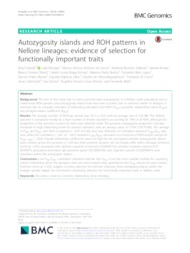Autozygosity islands and ROH patterns in Nellore lineages: evidence of selection for functionally important traits.
Autozygosity islands and ROH patterns in Nellore lineages: evidence of selection for functionally important traits.
Author(s): PERIPOLLI, E.; METZGER, J.; LEMOS, M. V. A. de; STAFUZZA, N. B.; KLUSKA, S.; OLIVIERI, B. F.; FEITOSA, F. L. B.; BERTON, M. P.; LOPES, F. B.; MUNARI, D. P.; LOBO, R. B.; MAGNABOSCO, C. de U.; DI CROCE, F.; OSTERSTOCK, J.; DENISE, S.; PEREIRA, A. S. C.; BALDI, F.
Summary: Abstract Background The aim of this study was to assess genome-wide autozygosity in a Nellore cattle population and to characterize ROH patterns and autozygosity islands that may have occurred due to selection within its lineages. It attempts also to compare estimates of inbreeding calculated from ROH (FROH), genomic relationship matrix (FGRM), and pedigree-based coefficient (FPED). Results The average number of ROH per animal was 55.15 ± 13.01 with an average size of 3.24 Mb. The Nellore genome is composed mostly by a high number of shorter segments accounting for 78% of all ROH, although the proportion of the genome covered by them was relatively small. The genome autozygosity proportion indicates moderate to high inbreeding levels for classical standards, with an average value of 7.15% (178.70 Mb). The average of FPED and FROH, and their correlations (− 0.05 to 0.26) were low. Estimates of correlation between FGRM-FPED was zero, while the correlation (− 0.01 to − 0.07) between FGRM-FROH decreased as a function of ROH length, except for FROH > 8Mb (− 0.03). Overall, inbreeding coefficients were not high for the genotyped animals. Autozygosity islands were evident across the genome (n = 62) and their genomic location did not largely differ within lineages. Enriched terms (p < 0.01) associated with defense response to bacteria (GO:0042742), immune complex reaction (GO:0045647), pregnancy-associated glycoproteins genes (GO:0030163), and organism growth (GO:0040014) were described within the autozygotic islands. Conclusions Low FPED-FROH correlation estimates indicate that FPED is not the most suitable method for capturing ancient inbreeding when the pedigree does not extend back many generations and FROH should be used instead. Enriched terms (p < 0.01) suggest a strong selection for immune response. Non-overlapping islands within the lineages greatly explain the mechanism underlying selection for functionally important traits in Nellore cattle.
Publication year: 2018
Types of publication: Journal article
Unit: Embrapa Cerrados
Keywords: Endogamia, Gado Nelore, Genoma, Genética Animal, Homozygosity, Padroes ROH
Observation
Some of Embrapa's publications are published as ePub files. To read them, use or download one of the following free software options to your computer or mobile device. Android: Google Play Books; IOS: iBooks; Windows and Linux: Calibre.
Access other publications
Access the Agricultural Research Database (BDPA) to consult Embrapa's full library collection and records.
Visit Embrapa Bookstore to purchase books and other publications sold by Embrapa.

